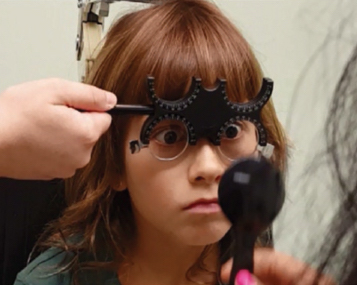 |
|
Some individuals with binocular vision problems may experience non-visual somatic symptoms, such as stomachache, palpitations and headaches. Photo: Jasleen Jhajj, OD. Click image to enlarge. |
As one small new study outlines, some individuals with binocular vision problems may experience non-visual somatic symptoms, such as stomachache, palpitations and headaches. Ocular symptoms, such as accommodation anomalies, are no different in these cases, and can appear and be caused or exacerbated by anxiety. As such, treatment in these circumstances is more difficult, especially since ophthalmic literature rarely cites resolution beyond ocular treatment alone.
The researchers of this study take a different approach, displaying characteristics and outcomes of 23 patients with accommodation spasms and weakness, then propose an adequate psychological approach to treatment.
Of the 23 included subjects—aged eight to 30 years—13 had severe accommodative weakness or ‘paralysis’ and 10 had accommodative spasms. Accommodation and convergence were assessed with a laboratory photorefractive method, orthoptic testing and dynamic retinoscopy. The researchers made sure that all patient interactions used an evidence-based psychological approach in which they gave insight to the patients how stress and anxiety can lead to eye symptoms. By providing this information, it helps to break the cycle of anxiety and deterioration risk.
The researchers of the study found that 57% of those included were diagnosed prior with anxiety or dyslexia and 87% of all subjects were female. Noted was the inconsistency of responses seen in all patients, although all showed normal response at some time during their visits. Their responses related poorly to presented visual stimuli and objective responses differed from subjective ones. Largely observed was dissociation between convergence and accommodation. After discussing the relation anxiety has with accommodative anomalies, responses improved significantly within one session. It was also found that none truly had accommodation paralysis.
The researchers outline that rather than focusing on ocular therapy alone, which can “deflect attention away from the real cause and can unwittingly be making things worse,” focusing attention on a more holistic approach allowed for them to incorporate methods that resolved the issue without further intervention. This included simple eye approaches, like low-key exercises and reading glasses, if necessary, reassurance and increasing patient insight, encouragement to stop checking or doing other things that could be making their problem worse and signposting to support if needed.
To offer an explanation for the ability to dissociate convergence and accommodation, the authors of the study believe that variable is normal, and the dissociation seen in these patients is likely an exaggeration of typical variation. They continue that it is perhaps a learned behavior or could reflect primary weak accommodation-convergence linkages.
While this will not be the case for all patients presenting with accommodation anomalies, this novel study provides new insight that is relevant to eyecare practitioners to at least be aware of. As the authors of the study put, “by giving patients (and their parents) insight into the underlying ocular and psychological mechanisms working to produce their symptoms it is possible to break vicious cycles, signpost to appropriate support and allow accommodation to return to being a subconscious mechanism.”
Horwood AM, Waite P. Using evidence-based psychological approaches to accommodation anomalies. Strabismus. January 29, 2023. [Epub ahead of print]. |


